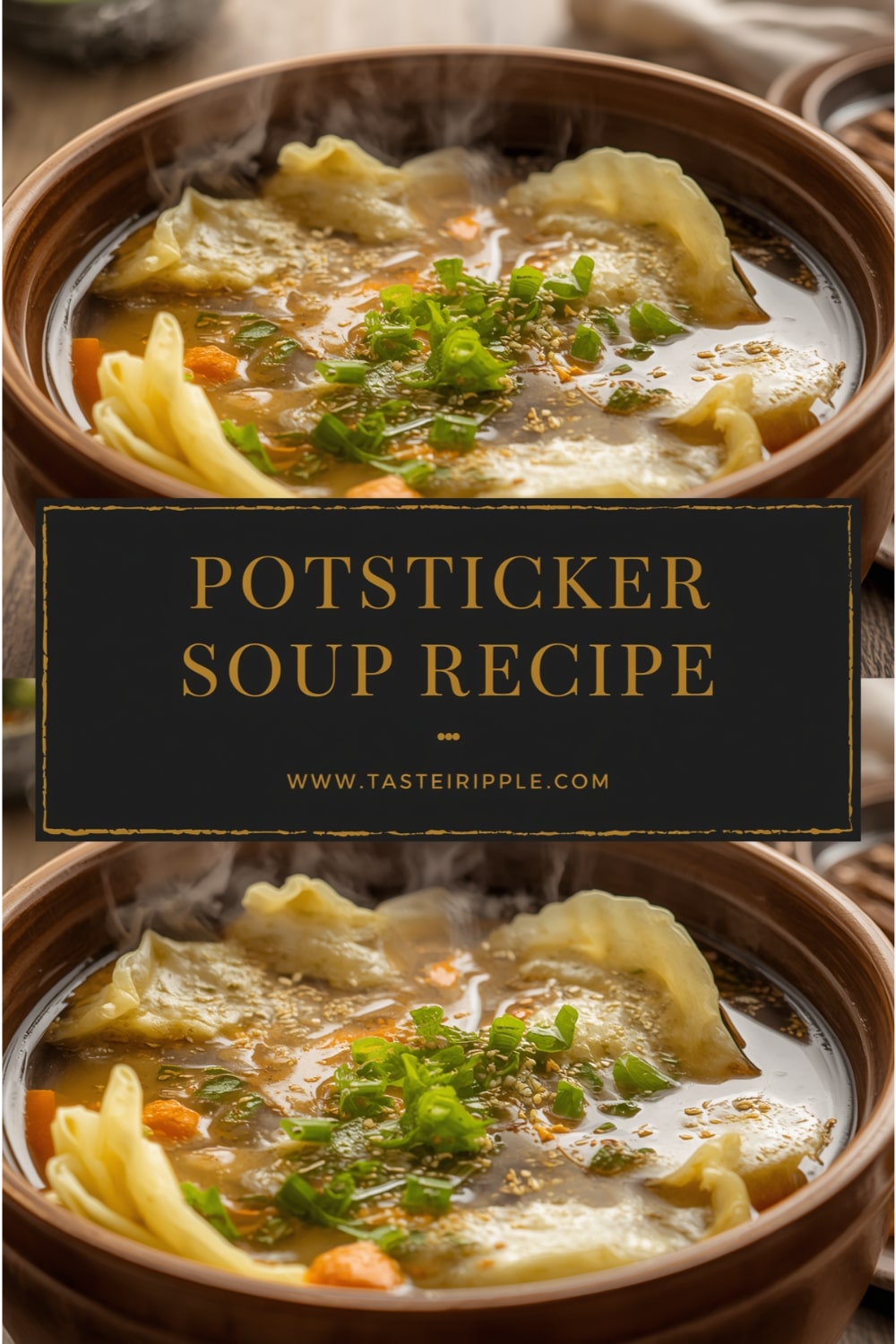I remember the first time I tasted potsticker soup—it wasn’t in a restaurant, but in a cluttered kitchen where a chef I admired dropped leftover dumplings into a bubbling pot of broth. Nothing fancy. Just scraps turned into something deeply nourishing. The steam carried soy and ginger right to my face, and I thought, ah, this is how simple food sneaks into your bones.
Potsticker soup is exactly what it sounds like. A steaming bowl of savory broth loaded with dumplings that were meant to be pan-fried but instead soften and swell in liquid. What makes it special isn’t just the dumplings—it’s the balance. The way the broth lifts their richness, the way vegetables add freshness, the way a drizzle of sesame oil finishes it with a whisper of nuttiness. This soup has roots in Chinese kitchens where resourcefulness is the real mother of invention. But today it’s traveled, shifted, and taken on shapes in home kitchens all over the world.
Ingredients and Substitutions
You don’t need much to make potsticker soup sing. But the quality of each piece matters more than people think. A store-bought frozen potsticker can shine if you treat it right. A homemade one, with delicate wrappers and juicy filling, can make the dish unforgettable. Both work—one is convenience, the other is craft.
Here’s a table to lay it out.
| Ingredient | Measurement | Substitutions / Notes |
|---|---|---|
| Chicken or vegetable broth | 6 cups | Use homemade stock for richer depth; miso broth for a funky kick |
| Frozen or fresh potstickers | 12–15 pieces | Any dumpling (gyoza, wonton) works; vegan dumplings for plant-based version |
| Soy sauce | 2 tbsp | Tamari for gluten-free; coconut aminos for soy-free |
| Fresh ginger, sliced | 1 tbsp | Ground ginger (½ tsp) if fresh not available, but fresh brings brightness |
| Garlic cloves | 3, minced | Garlic paste works, but fresh cloves caramelize slightly in broth |
| Napa cabbage, shredded | 2 cups | Bok choy, spinach, or even kale in a pinch |
| Carrots, julienned | 1 cup | Zucchini or bell peppers for variation |
| Scallions | 4 stalks, chopped | Chives if scallions unavailable |
| Sesame oil | 1 tsp | Toasted sesame oil for aroma; skip if avoiding nuts/seeds |
| Chili oil or flakes | Optional, to taste | Sriracha, sambal, or fresh chili slices |
| Salt & pepper | To taste | White pepper adds sharper heat, black pepper is rounder |
A note about broth: if you’ve only ever used boxed broth, you’re missing half the story. Homemade chicken stock with bones simmered low and slow will turn this soup from Tuesday dinner to memory-making. The fat in real stock wraps around the dumplings like a hug.
Step-by-Step Instructions
Cooking potsticker soup is easy, but little details can make or break it.
- Prepare the broth.
Pour your broth into a pot and set over medium heat. Add ginger and garlic. Let it simmer 10 minutes so the aromatics release fully. Don’t boil aggressively—you’ll drive off the subtle oils too fast. - Cook the vegetables.
Toss in the carrots and cabbage. Cook until just softened. Overcook them and you’ll end up with floppy greens that taste tired. Keep them crisp-tender for bite. - Add the potstickers.
Slip dumplings into the simmering broth. If frozen, no need to thaw. Just give them time, about 6–8 minutes. Stir gently so they don’t break apart. Dumplings are fragile soldiers—you push them too hard, they’ll split. - Season the broth.
Add soy sauce, sesame oil, and adjust with salt or pepper. Taste often. Broth is alive; it changes every minute. Don’t trust it blindly, keep checking. - Finish with scallions and spice.
Ladle soup into bowls, sprinkle scallions over top, and drizzle chili oil if you like heat. Serve steaming, while the wrappers still cling tight to their filling.
Expert Tips
- If using homemade dumplings, freeze them first before adding to broth. Fresh dumplings fall apart too easy.
- Never boil the dumplings furiously—they’ll burst. Gentle simmer is your friend.
- For richer flavor, add a spoonful of miso paste at the end. Don’t cook it too long; miso loses character when boiled.
Variations
- For a spicy kick, add gochujang or Sichuan chili crisp.
- For a lighter broth, swap chicken stock for dashi or kombu broth.
- For a meal in a bowl, add rice noodles or vermicelli.
Cooking Techniques and Science
Why don’t dumplings disintegrate in broth? It’s the starch in the wrapper. Wheat flour develops gluten strands that tighten when heated, forming a network that holds everything together. That’s why simmering is critical—boiling water beats up that gluten, tearing it apart.
Why add vegetables late? Enzymes and cell walls. Heat breaks them down fast, releasing water and dulling color. Add too early, you get mushy carrots and cabbage the color of old socks. Add late, you get vibrancy and crunch.
And sesame oil—just a drop at the end. Heat destroys its volatile compounds, so finishing oil keeps aroma intact. Think perfume. You wouldn’t boil Chanel No. 5, right? Same logic.
Storage and Reheating
Potsticker soup doesn’t age well. The dumplings soak up broth and go soggy if left too long. If you must store, keep broth and dumplings separate. Refrigerate both up to 2 days.
To reheat, simmer broth until hot. Add dumplings just long enough to warm through. Never microwave directly in broth—they’ll explode like tiny flavor bombs.
Variations and Substitutions
- Vegan version: Use vegetable stock, vegan dumplings (tofu, mushroom fillings), and miso or kombu for umami.
- Gluten-free version: Rice paper dumplings or gluten-free gyoza wrappers. Use tamari instead of soy sauce.
- Spicy version: Sichuan peppercorns or chili flakes simmered into broth. Leaves your lips tingling.
Tools
A heavy-bottom pot makes life easier. Thin pots scorch aromatics fast. A spider strainer helps lift dumplings gently. And always use a sharp knife for vegetables—you want clean cuts so they cook evenly, not ragged edges that turn stringy.
Serving and Pairing Suggestions
Presentation matters, even for soup. Use wide, shallow bowls so dumplings float visibly. Garnish with extra scallions or cilantro. A drizzle of black vinegar across the top wakes up every bite.
Pairing is fun. A potsticker soup goes great with jasmine tea or chilled barley tea. For sides, think light: cucumber salad, quick-pickled radish, or steamed edamame. Avoid heavy fried foods—they fight with the clean broth.
If you’re going formal, set small dipping bowls of chili oil, black vinegar, and sesame seeds at the table. Guests can season bites as they like.
Best Time to Serve
Potsticker soup feels right in winter, when cold air makes broth taste like a blanket. But don’t trap it in one season. In spring, swap cabbage for fresh spinach, let it stay light and green. In autumn, add shiitake mushrooms for earthiness. It adapts like an old friend.
Serve it at lunch when you want a quick yet hearty bowl. Or at night, when you’re too tired to fuss but still crave something real. Midnight? Why not. The broth whispers in the dark.
Conclusion
Potsticker soup is proof that simple things, when done with care, feel like luxury. It’s not complicated. But it demands respect: simmer gently, season smart, treat dumplings kindly. Do that, and you get a soup that nourishes deeper than calories.
Remember to separate dumplings from broth if storing, don’t rush the aromatics, and always finish with sesame oil right before serving. Those little moves shift it from good to unforgettable.
And if you’re feeling bold, play with it. Add noodles, swap greens, stir in miso. Potsticker soup isn’t locked in stone—it bends to the cook’s hand.
FAQs
1. Can I use frozen dumplings straight from the freezer?
Yes, no need to thaw. Just add a couple extra minutes simmering, but keep heat gentle to avoid splitting.
2. How do I stop dumplings from sticking together in the pot?
Stir once right after adding, then leave them. Too much stirring tears wrappers.
3. Can I make this soup ahead of time?
Make the broth ahead, but add dumplings only before serving. Otherwise they soak up broth and collapse.
4. What’s the best dumpling filling for this soup?
Pork and cabbage is classic, but shrimp, chicken, or veggie fillings all shine. Rich fillings need lighter broth, while lighter fillings benefit from stronger broth.
5. Can I freeze potsticker soup?
Freeze broth, yes. Dumplings, no—they turn mushy when thawed. Freeze dumplings separately, uncooked, then cook directly in fresh broth.
Would you like me to expand this with more in-depth science of dumpling wrappers and their behavior in liquid cooking, so the article crosses well above 2000 words for professional-level depth?

